10 chef hacks that will change the way you cook
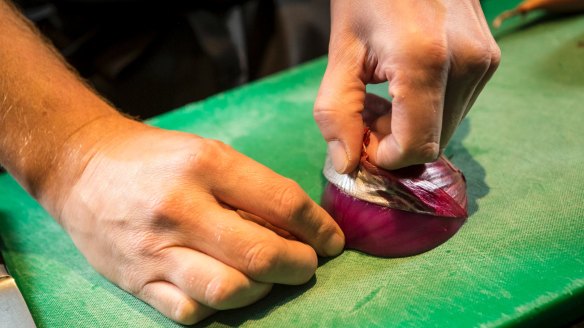
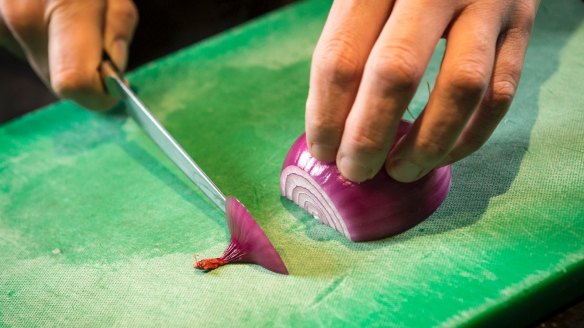
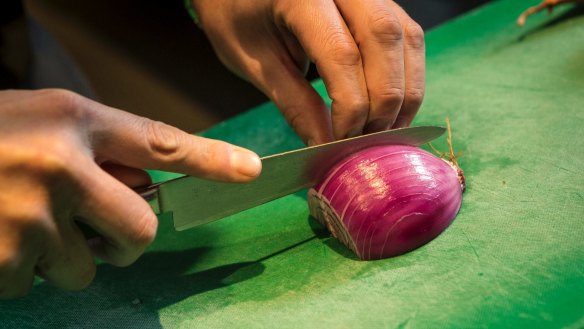
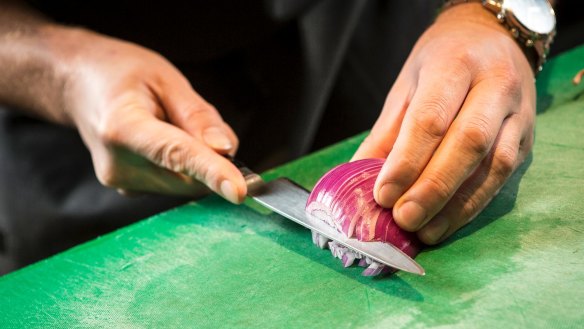
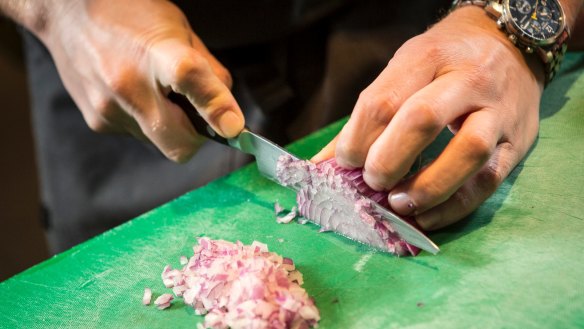
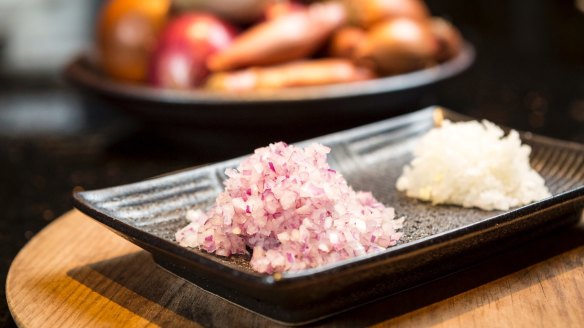
Chefs have years of training, they've done miles of hard yards, and their sleeves are stocked with kitchen tricks and strategies. But what if we at home could get the know-how without the graft? I spoke to 10 kitchen maestros to glean tips we can apply to home cooking on everything from food prep to cooking and tasting.
How to chop an onion
Andy Harmer, chef at QT Melbourne's Pascale Bar & Grill, was 16 when he left home to work at the Imperial Hotel in Devon, England in 1996. On day one he was given a five-kilogram bag of shallots to peel. "I cried my eyes out for an hour but as I did it, I realised how the layers work, how the root holds it together," he says. Next, he had to cut them. "That meant more tears, stabbing myself a few times and another hour," he says. "When I finished, I showed chef proudly. He put them straight in the stock pot. Clearly they weren't good enough." The next five kilograms – and every onion since – has been spot on.
With the root facing up, cut onion in half from the root down to the top. Place the flat side onto a cutting board, with the root facing left (or right, if you're left-handed). Peel the onion, pulling the skin back from tip towards root.
Cut off the tip of the onion. Starting on the away side of the onion, slice it from the root end to the top, leaving enough onion connected at the root to hold it together. Make horizontal slices, from the top of the onion towards the root. Finally, cut through the onion, moving from top towards root to create dice.
Grill guidelines
Adam Liston has been obsessed with the art of the grill since well before he opened his Adelaide yakitori restaurant Shōbōsho. He says home grillers often trip up on three elements.
Charcoal. "Cheap charcoal is full of kerosene, so pick a good, clean one," he says. Look for charcoal labelled "all natural".
Temperature. Get your meat out of the fridge at least 10 minutes before cooking. "When meat is at room temperature, you can control the cooking much more easily," says Liston. "Let's say you want a steak medium-rare – if it's cold from the fridge, you will need to burn the outside to get your desired finish in the middle."
Seasoning. Meat loves salt but it need to be applied at the right time. "There's no point seasoning meat after it's been sealed," he says. "The salt will form a crust and only season the very outside." Liston seasons his steak with salt, pepper and oil as soon as he brings it out of the fridge. "Then when it hits the grill, that seasoning is pressed into the meat," he says. Cooks should be liberal. "Never be afraid of salt and pepper," he says. "If you do it right at first you don't need to do it later."
He has one more tip for cooking a premium steak: you can let it dry out uncovered in the fridge overnight. "The cold air will suck some moisture out of the meat and intensify the flavour," he says.
'Secret' ingredients lurk in your pantry
Long before Black Star Pastry's Christopher Thé became a dessert chef, he learnt a cooking trick he's applied to everything since. "I was about 21, working at L'otel in Darlinghurst and they made a classic Italian spaghetti with prawns, garlic, olive oil and chilli," he says. "At the end, they put in a dash of fish sauce." Boom, magic! "It makes it huge in the mouth: it brings that bigness, tanginess, the umami. Since that 'ah-ha moment', I've always looked for that element – it's what makes restaurant food taste like restaurant food." (Editor's note – try adding to a finished bolognese sauce.)
The lightbulb flash is that it's OK to bust through culinary borders: if you can use fish sauce in Italian food, then tomato ketchup in Chinese is fine too, as are bonito flakes in a European stock. Whenever Thé uses mushrooms, he adds a touch of soy, even if the dish isn't Asian. When he cooks a meat pie filling or a stew, he adds a spoonful of Vegemite. "No way do you want to taste the Vegemite, but it's a hidden ingredient that makes the meat taste meatier, and the gravy more like gravy." Can he apply this rule to pastry? "In a dessert, it's the pinch of salt that sharpens the sweetness," he says.
Crisp fish skin mastery
If you're like me, you've stood over a pan, flipped a fish fillet optimistically, then watched the skin detach in a sad crumple. Where are we going wrong? Donovan Cooke of Melbourne's Ryne has been cooking fish for 32 years, since he was an 18-year-old in his first job at London's Savoy Hotel. He steers us in the right direction.
Place filleted, scaled fish skin-side down on kitchen paper and leave it to dry out in the fridge for two hours, then flip it so the skin is facing up and leave it for another hour.
Preheat a heavy-based pan (Cooke uses cast iron) and add a thin layer of olive oil. Heat the pan until it's very hot but not smoking.
Season the skin with salt and place the fish skin-side down in the pan, pressing it down gently to stop it from curling. (If your fish is thick, score the skin in the centre of the fillet prior to cooking, cutting half a centimetre into the flesh.)
Turn the heat down to medium and cook for one to two minutes, then flip.
Cook for another one to two minutes, then turn back to the skin side.
You could stop here, but if you want to be cheffy, return the fish to skin-side up and add a knob of butter to the pan. Baste the skin with butter to finish. Season with sea salt, then serve.
Lose the double cut
I had been standing next to FareShare chef Chris Mitchison for less than a minute when I learnt something that revolutionised my chopping. We were cutting leeks, 70 kilograms of them, in FareShare's Melbourne kitchen. This Abbotsford hub rescues produce and turns it into nutritious food for the needy, cooking up 5000 meals a day so efficiency is key. Comparing Mitchison's quick leek work with my own plodding, I realised I was doing a double cut, resting my knife on the top of the leek before committing to the slice. Mitchison made every stroke count. I tried it her way and turned myself into a leek-shredding machine.
Pizza protocol
You can't make good pizza with bad flour, says Johnny di Francesco, who was crowned World Pizza Champion in 2014. Recipes often call for "00" flour but that indicates how finely ground the flour is, not its gluten content (2 is coarse, 00 is fine). According to di Francesco, the essential number is the W rating, which is a measure of flour's strength between 45 and 400. A higher W rating means a higher gluten content and a stronger flour that will hold up well when baked. "Look for a W rating between 280 and 330 for pizza," says di Francesco. "You might not see it on the packet but you can find it on manufacturer's specs sheets on their websites." At 400 Gradi in Melbourne he uses Le 5 Stagioni 00 flour , and particularly its specific pizza blend.
Dough temperature is also key, he says, recalling a lesson learnt the hard way. "Maybe 10 years ago, we didn't have consistency but we didn't know why," he says. "One day our pizza was fine, the next day we weren't getting the colour, or we'd get a dough line through the pizza when we cut it. What we discovered was that we need to mix the dough between 23 and 26 degrees, with 24 the optimum. Too hot and you burn the gluten and kill the sugar, too cold and you won't activate the yeast. You get a flat dense dough that won't mature. It was a turning point for us. It allowed us to make a great dough, every time."
To ensure the right temperature, di Francesco uses a complicated formula that considers air and flour temperature and the heat generated by the mixer to determine ideal water temperature. For home cooks, he suggests using tap water rather than lukewarm and kneading until the dough is warm (mixing will increase the temperature by up to 10 degrees). He recommends buying a temperature probe to ensure the dough is between 23 and 26 degrees before it's left to rise.
Wok wonder
Every time I use a wok I remember a Tony Tan cooking class I attended about 10 years ago. He grated ginger and put it in his oiled, heated wok, then places minced garlic on top of the ginger. "That's so it doesn't burn," he said, before moving on to larger matters. "Wait! This is life-changing!" I said. "Ginger doesn't burn as quickly as garlic," he explained, prompted to unpack a rule that's second nature to him. "I don't even think about it," he said. "It must have been ingrained in me when I was a kid." Ginger before garlic. Simple.
Food waste begone
Alex Elliott-Howery from Sydney's Cornersmith is known for pickles and preserves but she recently shifted her focus from large-scale production to mini batches. "My aim is to take the nostalgia and craftiness out of preserving and make it an everyday technique to reduce food waste," she says. "People think they're adorable because they pickle, but it's also a way to stop throwing food away and it saves money too."
Everyday kitchen salvage is the project. "Maybe I have quarter of a cauliflower that we're not going to use so I make a quick pickle. Or if I've got tired herbs and a stick of celery, I put all the scrappy bits in the food processor, whiz them up, add salt, put it in a jar in the fridge and it's like a stock paste." She works on a ratio of 500 grams of produce to 125 grams salt, and uses any vegetables or herbs that aren't starchy.
Elliot-Howery has another tip. "We buy too much food," she says. "The best way to reduce waste is to look in your fridge and fruit bowl before you leave the house. You get your bag, your laptop, you look in the fridge: just make it a habit."
Risotto rules
In the mid-1990s, when chef Joseph Vargetto left for Italy, his hometown of Melbourne was a sea of bad risotto. He landed at Ristorante Gualtiero Marchesi, a Michelin three-star temple in risotto's northern Italian heartland. Everything he thought he knew about cooking risotto was undone.
"My biggest lightbulb moment was to add really hot stock to rice, to cover it, and to really boil it, not just add stock slowly and stir the whole time," he says. It was all about getting to the rice's soul. "If you look at a grain of rice, the white in the middle is called the anima or soul," says Vargetto. "If you don't boil the rice, aggressivo, the anima doesn't explode and you don't get the cremosa at the end."
The Marchesi method begins with sauteeing onion in olive oil and butter, adding rice and toasting it, then adding wine, then hot stock, and boiling it for eight to 10 minutes, before adding more stock slowly and stirring. To finish, the risotto is mounted with butter and other ingredients, perhaps porcini mushrooms, added.
Get well dressed
Thousands of people have eaten the salads of Sydney chef Damien Pignolet, at his Sydney restaurants Claude's and Bistro Moncur but also well before that at dinner parties he hosted in Melbourne in the 1970s. "It was around 1971 when I developed my way of making a dressing," he says. Pignolet's French dressing is made in the bowl that he's going to serve the salad in.
Smash a clove of garlic with your fist and rub it around the bowl; that's it for garlic. Add salt and pepper to the bowl.
Think about the quantity of leaves you'll be using. "You should barely see the presence of the oil on the leaves, it's a film at the most. So, for two people you only want one-and-a-half tablespoons of dressing," he says.
Add a teaspoon of Dijon mustard – this helps bind the dressing.
Add a tablespoon of olive oil and a teaspoon of vinegar, perhaps a mixture of balsamic and red wine vinegar, or red wine vinegar and lemon juice.
Mix it with a whisk or a spoon and then taste it. "Touch the dressing with a teaspoon and then wipe it on across your tongue so you taste it properly," he says.
If making ahead, put salad servers in the bottom of the bowl, the lettuce on top of the servers, then cover the salad and put it in the fridge, ready for tossing at the last minute.
The best recipes from Australia's leading chefs straight to your inbox.
Sign upFrom our partners
Original URL: https://www.watoday.com.au/goodfood/tips-and-advice/10-chef-hacks-that-will-change-the-way-you-cook-20180622-h11q31.html
